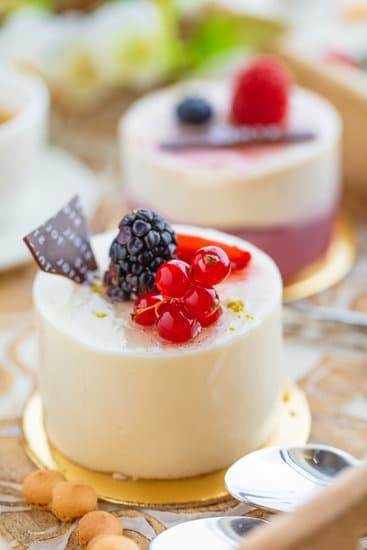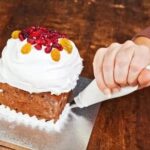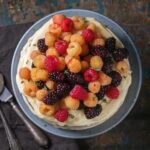Are you looking to learn how to simply decorate a cake? Decorating a cake can seem like a daunting task, but with the right tools and techniques, it can be a fun and creative endeavor. Whether you’re celebrating a special occasion or just want to impress your friends and family, being able to beautifully decorate a cake is a skill worth mastering.
When it comes to cake decorating, having the basic tools is essential. From piping bags to offset spatulas, these tools will help you achieve professional-looking results. Additionally, choosing the right type of cake for decorating is crucial as some cakes are better suited for certain techniques than others.
In this article, we will explore the necessary tools for cake decorating, tips for preparing your cake for decoration, different types of frosting and icing to use, as well as step-by-step instructions on how to apply frosting. We’ll also delve into creative decorating techniques for beginners and how to add finishing touches and personalization to your cakes. Follow along to elevate your baking skills and create stunning cakes that are sure to impress.
The Basic Tools You’ll Need for Cake Decorating
When it comes to decorating a cake, having the right tools can make all the difference in achieving a professional-looking result. Whether you are a beginner or more experienced baker, there are a few basic tools that are essential for cake decorating.
One of the most important tools is a good quality offset spatula, which is used for spreading frosting and smoothing out surfaces. A piping bag with various tips is also crucial for creating different designs and patterns on your cake.
Another essential tool for cake decorating is a turntable, which allows you to easily rotate the cake as you work on it, ensuring even coverage of frosting and decorations. Parchment paper or wax paper can be used to create templates for intricate designs or to prevent sticking when rolling out fondant. Additionally, a sharp serrated knife or cake leveler is necessary for trimming and leveling cakes before decorating.
To add some extra flair to your decorated cakes, consider investing in decorative stencils, edible markers, edible glitter or pearls, and food coloring gels. These tools can help you personalize your cakes with messages, patterns, and designs that suit any occasion. With these basic tools on hand, you’ll be well-equipped to tackle any decorating project and create stunning cakes that will impress your friends and family.
Choosing the Right Cake for Decorating
Consider the Texture
When choosing a cake for decorating, it is important to consider the texture of the cake itself. A denser, firmer cake, such as a pound cake or a sponge cake, may hold up better to elaborate decorations and intricate designs. On the other hand, if you are planning on using lighter decorations like whipped cream or fresh fruits, a lighter and fluffier cake like chiffon or angel food might be more appropriate.
Flavor Profile
Another factor to consider when selecting a cake for decorating is the flavor profile. Certain flavors may complement specific types of decorations better than others. For example, a rich chocolate cake can pair well with bold, vibrant decorations such as colored fondant or buttercream flowers. A vanilla or lemon-flavored cake may be better suited for more delicate and subtle decorations.
Size and Shape
Lastly, take into account the size and shape of the cake when choosing one for decorating. Depending on your design ideas, you may need a larger or smaller size cake. Additionally, consider whether you want to work with round cakes, sheet cakes, or perhaps even sculpted cakes for more advanced decorating projects. By selecting the right size and shape of the cake from the start, you can streamline the decorating process and achieve better results.
By carefully considering these factors – texture, flavor profile, size, and shape – you can ensure that you have selected the perfect base for your decoration endeavors. Keep in mind that experimenting with different types of cakes can also add excitement to your baking and decorating journey.
Tips for Preparing Your Cake for Decorating
When it comes to decorating a cake, the preparation of the cake itself plays a crucial role in achieving a beautifully decorated end result. Before you start adding frosting and decorations, it’s important to ensure that your cake is properly prepared. Here are some tips to help you get your cake ready for decorating:
- Let your cake cool completely before starting the decoration process. Decorating a warm or hot cake can cause the frosting to melt and slide off.
- Level your cake layers using a serrated knife or a cake leveler. This will ensure that your cake has an even surface for decorating.
- Consider applying a crumb coat before adding the final layer of frosting. A crumb coat is a thin layer of frosting that helps seal in any loose crumbs, preventing them from getting mixed into the final layer of frosting.
Prepping your cake properly can make a huge difference in the final outcome of your decorated creation. By following these simple tips, you can set yourself up for success when it comes to creating beautifully decorated cakes.
Remember, the key to successfully decorating a cake is taking the time to properly prepare each step along the way. So take your time and pay attention to detail as you prepare your cake for decorating. With the right tools and techniques, you’ll be on your way to creating stunning cakes that not only look great but taste delicious too.
Different Types of Frosting and Icing to Use
When it comes to decorating a cake, choosing the right type of frosting or icing is crucial in achieving the desired look and taste. There are several options available, each with its own unique characteristics and uses. Buttercream frosting is a popular choice for many beginners due to its versatility and ease of use. Made from butter, powdered sugar, and flavorings, buttercream can be easily colored and piped onto cakes for different designs.
Another common option for cake decorating is fondant, a smooth and pliable icing that can be rolled out and draped over cakes for a polished finish. Fondant allows for intricate designs and decorations, making it ideal for special occasions like weddings or birthdays. Ganache, a mixture of chocolate and cream, is another favorite among bakers for its rich taste and smooth texture. It can be used as both a filling and frosting for cakes.
For those looking to achieve a glossy finish on their cakes, mirror glaze is an excellent choice. This shiny coating is made from gelatin, sugar, water, and condensed milk, creating a stunning effect that will impress any guest. Whichever type of frosting or icing you choose to use on your cake, it’s important to consider the overall flavor profile and design aesthetic you want to achieve. Experiment with different types to find the perfect match for your baking project.
Whether you prefer the simplicity of buttercream or the elegance of fondant, there are endless possibilities when it comes to decorating a cake. With the right tools and techniques, you can create beautiful designs that will wow your friends and family.
In the following sections, we will explore step-by-step guides on how to apply different types of frosting and icing to your cake, as well as creative decorating techniques for beginners looking to take their skills to the next level.
Step-by-Step Guide on How to Apply Frosting
Applying frosting to a cake is a crucial step in the cake decorating process that requires some skill and technique. To start, you will need the right tools for the job, which include an offset spatula, a bench scraper, and piping bags with various tips for different designs. Before you begin the frosting process, make sure your cake is completely cooled and leveled to ensure an even decorating surface.
To apply frosting smoothly and evenly on your cake, start by placing a dollop of frosting on top of your cake layer. Using an offset spatula, spread the frosting evenly over the top of the cake, pushing any excess over the edges to create a crumb coat. This initial thin layer of frosting will seal in any loose crumbs and provide a smooth base for your final coat of frosting.
Once your crumb coat is set, add more frosting to cover the entire cake with a thicker layer. Use an offset spatula or bench scraper to smooth out the frosting on the sides and top of the cake until it is level and even.
If you want to achieve a smooth finish, dip your spatula in hot water and run it over the surface of the cake to remove any imperfections. Alternatively, you can create texture or patterns with different tools for a more decorative look.
| Frosting Application Tips | Data |
|---|---|
| Use an offset spatula for even spreading | Check |
| Dip spatula in hot water for smooth finish | Check |
| Choose appropriate tools for texture or patterns | Check |
Creative Cake Decorating Techniques for Beginners
Choosing the Right Technique
When it comes to creative cake decorating, there are numerous techniques that beginners can easily master. One popular technique is using a frosting comb to create unique patterns on the sides of your cake. Another simple yet effective technique is piping buttercream flowers on top of your cake for a beautiful and elegant look. Experiment with different tips and techniques to find what works best for you and your design.
Using Fondant for Designs
Fondant is a versatile material that can be used to create intricate designs on cakes. To use fondant, simply roll it out with a rolling pin, then carefully drape it over your cake. Smooth out any wrinkles or air bubbles with a fondant smoother or your hands. Use cookie cutters or fondant cutters to create shapes and designs, then attach them to your cake using a small amount of water or edible glue.
Creating Ombre or Watercolor Effects
For a trendy and modern look, consider trying ombre or watercolor effects on your cake. To achieve an ombre effect, tint your buttercream frosting in varying shades of the same color, then apply them to your cake in gradient layers. For a watercolor effect, thin out your icing with water or corn syrup and use a paintbrush to apply the colors in a soft, blended pattern. These techniques are sure to impress without requiring advanced skills in cake decorating.
By experimenting with different creative cake decorating techniques as a beginner, you can discover new ways to enhance the appearance of your cakes. Remember to have fun and let your creativity shine through as you practice these techniques. With patience and practice, you’ll soon be able to decorate cakes like a pro using simple yet effective methods.
Adding Finishing Touches and Personalization
Decorating a cake is not just about applying frosting or icing; it’s also about adding those final touches that make your creation truly stand out. Whether you’re looking to add a personal touch to a birthday cake or simply want to enhance the overall look of your dessert, here are some tips on how to add those finishing touches:
- Use fresh fruit: One simple yet effective way to decorate a cake is by using fresh fruit. Not only does it add color and vibrancy, but it also provides a refreshing contrast to the sweetness of the cake. From sliced strawberries to kiwi flowers, the possibilities are endless.
- Get creative with piping: Piping can elevate your cake decoration game significantly. Whether you’re using buttercream or royal icing, piping intricate designs, borders, or even writing personalized messages can add a professional touch to your creation.
- Experiment with edible decorations: Edible decorations come in various forms, such as sprinkles, edible glitter, chocolate shavings, and more. These embellishments can be used to add texture, sparkle, and whimsy to your cake.
Remember that adding finishing touches is your chance to showcase your creativity and personalize your cake according to the occasion or recipient. Don’t be afraid to experiment with different techniques and materials until you find what works best for you. By paying attention to these final details, you can take your decorated cake from good to great in no time.
Conclusion and Final Tips for Success
In conclusion, learning how to simply decorate a cake can be a fun and rewarding experience for beginners. By mastering the basic tools needed for cake decorating and choosing the right cake to work with, you can set yourself up for success. Preparing your cake properly and selecting the right type of frosting or icing are crucial steps in achieving a beautifully decorated cake.
Following a step-by-step guide on how to apply frosting will help you create a smooth and professional-looking finish. Additionally, exploring different creative cake decorating techniques can add flair and charm to your creations. Remember to personalize your cakes by adding finishing touches that reflect your individual style.
To truly excel at cake decorating, practice is key. Don’t be afraid to experiment with new techniques and designs. With time and patience, you will develop your skills and confidence in creating stunning cakes. So gather your tools, pick out a delicious cake recipe, and get ready to impress your friends and family with your newfound ability to decorate cakes like a pro.
Frequently Asked Questions
How Do You Decorate a Cake Simply?
Decorating a cake simply can be achieved by using basic techniques such as spreading a smooth layer of frosting, adding sprinkles or edible decorations, piping a simple border, or using fresh fruits or flowers for a natural touch.
How to Decorate Cake in Home Simple?
Decorating a cake at home can be kept simple by using easily accessible tools and ingredients. Consider using a buttercream frosting to cover the cake and add texture with a spatula or knife. Adding some colorful sprinkles or edible glitter can also elevate the look.
How Do You Make a Simple Cake Look Fancy?
To make a simple cake look fancy, you can focus on presentation and detail. Use different piping tips to create intricate designs on the cake’s surface, add layers with different colored frostings, incorporate fondant decorations, or utilize edible paints for an artistic touch.
Additionally, incorporating fresh berries or gold leaf accents can instantly add elegance to the overall appearance of the cake.

Welcome to our cake decorating blog! My name is Destiny Flores, and I am the proud owner of a cake decorating business named Cake Karma. Our mission is to provide delicious, beautiful cakes for all occasions. We specialize in creating custom cakes that are tailored specifically to each customer’s individual needs and tastes.





